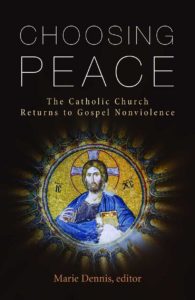Choosing Peace: The Catholic Church Returns to Gospel Nonviolence
Reviewed by Steve Chase
October 1, 2019
 Edited by Marie Dennis. Orbis Books, 2018. 272 pages. $25/paperback; $20.50/eBook.
Edited by Marie Dennis. Orbis Books, 2018. 272 pages. $25/paperback; $20.50/eBook.
For Quakers interested in more than the passive avoidance of violence, Choosing Peace will be a chance to learn how other Christians—Catholics in particular—work to find the sweet spot between Christian pacifism and “just war” perspectives. I am a Friend who has long sought to find a meaningful position between those extremes. Indeed, I raised some eyebrows among the editors at QuakerPress when I told the story in my book Letters to a Fellow Seeker about the day I stopped being a pacifist and became a Gandhian. Interestingly, this essay collection by the Catholic Nonviolence Initiative (CNI), a project of Pax Christi International, seeks a similar move to converge in this sweet spot, from a different direction, with their wholehearted embrace of “nonviolent resistance, restorative justice, trauma healing, unarmed civilian protection, conflict transformation, and peacebuilding.”
This statement and the formation of the CNI was an outcome of the Vatican-sanctioned Nonviolence and Just Peace Conference held in Rome on April 11–13, 2016. The conference, co-organized by Pax Christi International and the Pontifical Council for Justice and Peace among other groups, included more than 80 scholars, theologians, priests, bishops, lay leaders, and congregational members from Africa, the Americas, Asia, Europe, the Middle East, and Oceania. The participants were even welcomed with a message from Pope Francis, read by Cardinal Peter Turkson, president of the Pontifical Council, on the first day: “Your thoughts on revitalizing the tools of nonviolence, and of active nonviolence in particular, will be a needed and positive contribution.”
What these participants reflected on during this three-day conference is now available for all to consider in Choosing Peace: The Catholic Church Returns to Gospel Nonviolence, a collection of key conference papers, talks, and responses skillfully edited and introduced by Marie Dennis, co-president of Pax Christi International. Her book is a nuanced discussion of a profound shift beginning to take place in the largest Christian denomination in the world.
Maria J. Stephan notes in her chapter “Active Nonviolence: An Effective Political Tool”:
Nonviolent struggle draws on courage, strategic planning, and, for many people involved in nonviolent resistance, on spiritual discipline and motivation. In many of the most iconic historical nonviolent movements, from the Catholic Worker movement, to the US civil rights movement, to the People Power struggle for democracy in the Philippines, to the struggles against dictatorship in Poland, Argentina, and Chile, Catholic and Christian faith communities and institutions played pivotal roles in exposing injustices, encouraging global solidarity, providing organizational strength, and offering spiritual nourishment for activists and nonviolent change agents.
Now imagine, as Dennis and the CNI do, what might happen “if Catholics were formed from the beginning of life to understand and appreciate the power of active nonviolence and the connection of nonviolence to the heart of the gospel?” What if the institutional Catholic Church devoted much of its vast financial, intellectual, and spiritual resources to “integrate Gospel nonviolence explicitly into the life, including the sacramental life, and work of the Church through dioceses, parishes, agencies, schools, universities, seminaries, religious orders, voluntary associations, and others”? What if, as Maria Stephan suggests in one of her comments at the conference, the Church also “joined forces with other Christian denominations, along with Muslim and Jewish leaders and institutions, to prioritize areas of collaboration focused on Abrahamic peacemaking”?
To move this ministry forward, the authors in this collection build a strong case for re-centering a just peace perspective within the Catholic Church. First, they focus our attention on the intense negative costs of warfare, violent revolution and repression, and small group political violence and terrorism that contributes to our “broken world.” Second, they tell some inspiring stories about on-the-ground nonviolent initiatives to secure a just peace undertaken by church members in Afghanistan, the Philippines, South Sudan, Mexico, Croatia, South Korea, the United States, Peru, Uganda, Kenya, Palestine, and the United Kingdom. Third, they refocus the faithful’s attention on the scriptural foundations of the gospel commitment to creative nonviolent action. Fourth, they spotlight the ongoing, but unfinished, evolution away from a “just war” perspective within official Catholic social teaching. Finally, they focus our attention on the best available social science research on a wide variety of nonviolent just peace practices as well as how their effectiveness compares to violent strategies and behaviors.
Stephan’s chapter makes a major contribution on this last point by offering a detailed description of the research findings of her groundbreaking study with Erica Chenoweth in their prize-winning book Why Civil Resistance Works: The Strategic Logic of Nonviolent Conflict (reviewed in FJ Mar. 2013). Based on these findings, the statement released at the end of the conference (titled “An appeal to the Catholic Church to re-commit to the centrality of Gospel nonviolence”) correctly asserts that “recent academic research . . . has confirmed that nonviolent resistance strategies are twice as effective as violent ones.”



Comments on Friendsjournal.org may be used in the Forum of the print magazine and may be edited for length and clarity.